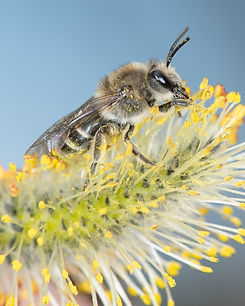
Family Halictidae > Genus Sphecodes
Sphecodes
Blood Bees
In Minnesota, there are twenty-six described species within the genus Sphecodes. Bees in this genus are cleptoparasitic (cuckoo bees). Their hosts include sweat bees within the genera Halictus, Augochlorella, Augochloropsis, and Lasioglossum as well as ground-nesting Andrena, Colletes, Calliopsis, and Perdita. Additional ground-nesting hosts are possible because the host relationship information for Sphecodes is understudied.
Sphecodes have a black head and thorax, and either an entirely red abdomen or red abdomen with black markings (although some species can have an entirely black abdomen). Most species have three forewing submarginal cells; a minority have two. Females lack pollen-collecting structures. Bees in this genus can be extremely small- to medium-sized and range in length from 2 to 13 mm (0.07 to 0.5 inches). The physical size of a given species often, but not always, is similar in size to the host.
Sphecodes females can be observed on flowers or near their host's ground nest, perching on the ground or on vegetation next to the nest. When the host leaves, the Sphecodes female enters the nest and searches for a fully provisioned brood cell with an egg laid on the pollen mass. Then, after destroying that egg, she lays one of her own in the brood cell. For other cuckoo bee genera, in the first instar stage, it's typical for the cuckoo bee larva to develop sickle-like mandibles that are employed to kill the host egg (or larva). These large mandibles are not present in the following instar stages of the cuckoo bee larva.

A Sphecodes female visiting Zizia aurea.

A black Sphecodes male visiting Eupatorium perfoliatum.

A Sphecodes female investigates a Halictus rubicundus nest aggregation as the Halictus nest guards monitor her activity and block access to the nest.

wing
position
on flowers

N0. species in MN
26
size range

Phenology

Genus Characteristics

Head and thorax black and lacking metallic highlights. Abdomen completely red or orange, or partially black (rarely all-black).

Males and females relatively hairless and wasp-like. Females lack pollen-collecting structures.
Distribution

Sphecodes antennariae

Sphecodes atlantis

Sphecodes banksii

Sphecodes clematidis

Sphecodes confertus

Sphecodes coronus

Sphecodes cressonii

Sphecodes davisii

Sphecodes dichrous

Sphecodes fattigi

Sphecodes galerus

Sphecodes heraclei

Sphecodes hydrangeae

Sphecodes illinoensis

Sphecodes johnsonii

Sphecodes levis

Sphecodes mandibularis

Sphecodes minor

Sphecodes nigricorpus

Sphecodes pecosensis

Sphecodes pimpinellae

Sphecodes prosphorus

Sphecodes ranunculi

Sphecodes smilacinae

Sphecodes solonis

Sphecodes townesi
Sphecodes Species in Minnesota
Scientific Name | Host |
|---|---|
Sphecodes antennariae | |
Sphecodes atlantis | Lasioglossum pilosum (Eickwort 1978) |
Sphecodes banksii | Lasioglossum vierecki (Gibbs 2023) |
Sphecodes clematidis | |
Sphecodes confertus | |
Sphecodes coronus | |
Sphecodes cressonii | |
Sphecodes davisii | |
Sphecodes dichrous | |
Sphecodes fattigi | |
Sphecodes galerus | |
Sphecodes heraclei | |
Sphecodes hydrangeae | |
Sphecodes illinoensis | |
Sphecodes johnsonii | |
Sphecodes levis | Lasioglossum quebecense (Crawford 1907; Eickwort 1978) |
Sphecodes mandibularis | |
Sphecodes minor | |
Sphecodes nigricorpus | |
Sphecodes pecosensis | |
Sphecodes pimpinellae | Augochlorella (Ordway 1964) |
Sphecodes prosphorus | |
Sphecodes ranunculi | |
Sphecodes smilacinae | |
Sphecodes solonis | |
Sphecodes townesi | Halictidae |
Source: Minnesota Department of Natural Resources, Minnesota Bee Species List (August 2023).
https://files.dnr.state.mn.us/eco/mcbs/mn-statewide-bee-list.pdf
Explore More Halictidae Genera
Explore Bee Families

Apidae
15 genera, 133 species
Bumble bees Bombus
Longhorn bees
Epimelissodes, Eucera, Melissodes
Carpenter bees
Ceratina, Xylocopa
Honey bees Apis
Digger bees Anthophora
Cuckoo bees Brachymelecta, Epeolus, Holcopasites, Nomada, Neolarra, Triepeolus
Squash bees Xenoglossa

2 genera, 39 species
Halictidae
10 genera, 133 species
Metallic green sweat bees
Agapostemon, Augochlora, Augochlorella, Augochloropsis
Large sweat bees
Dieunomia, Nomia
Short-faced bees Dufourea
Sweat bees Halictus
Small sweat bees Lasioglossum
Cuckoo (blood) bees Sphecodes
Megachilidae
14 genera, 86 species
Resin and pebble bees Anthidiellum, Dianthidium, Heriades, Paranthidium
Carder bees Anthidium, Pseudoanthidium
Mock orange bees Chelostoma
Mason bees Osmia, Hoplitis
Leafcutter bees Megachile
Sharp-tailed cuckoo bees Coelioxys
Dark cuckoo bees Stelis

Citations and Further Reading
Droege, S., et al. (2024). The Very Handy Bee Manual: 2.0. How to Catch and Identify Bees and Manage a Collection.
Gibbs, J., Hanuschuk, E., Miller, R., Dubois, M., Martini, M., Robinson, S., ... & Onuferko, T. M. (2023). A checklist of the bees (Hymenoptera: Apoidea) of Manitoba, Canada. The Canadian Entomologist, 155, e3.
Mitchell, T. B. (1960). Bees of the eastern United States. Technical Bulletin No. 141. North Carolina Agricultural Experiment Station.
Portman, Z. M., Gardner, J., Lane, I. G., Gerjets, N., Petersen, J. D., Ascher, J. S., ... & Cariveau, D. P. (2023). A checklist of the bees (Hymenoptera: Apoidea) of Minnesota. Zootaxa, 5304(1), 1-95.
Wilson, J. S., & Messinger Carril, O. J. (2016). The bees in your backyard: a guide to North America's bees. Princeton University Press.













